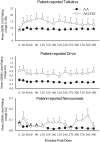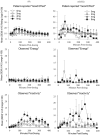Polymorphisms in the A118G SNP of the OPRM1 gene produce different experiences of opioids: A human laboratory phenotype-genotype assessment
- PMID: 38221808
- PMCID: PMC10898793
- DOI: 10.1111/adb.13355
Polymorphisms in the A118G SNP of the OPRM1 gene produce different experiences of opioids: A human laboratory phenotype-genotype assessment
Abstract
Allelic variations in the A118G SNP of the OPRM1 gene change opioid signaling; however, evaluations of how allelic differences may influence opioid effects are lacking. This human laboratory paradigm examined whether the AA versus AG/GG genotypes determined opioid response profiles. Individuals with limited opioid exposure (N = 100) completed a five-day within-subject, double-blind, placebo-controlled, residential study. Participants were admitted (Day 1), received 4 mg hydromorphone (Day 2) and 0 mg, 2 mg and 8 mg hydromorphone in randomized order (Days 3-5) and completed self-reported visual analog scale (VAS) ratings and Likert scales, observed VAS, and physiological responses at baseline and for 6.5 h post-dose. Outcomes were analysed as peak/nadir effects over time as a function of genotype (available for N = 96 individuals; AG/GG = 13.5%, AA = 86.4%). Participants with AG/GG rated low and moderate doses of hydromorphone as significantly more positive (e.g., Good Effects VAS, coasting, drive, friendly, talkative, stimulation) with fewer negative effects (e.g., itchy skin, nausea, sleepiness), and were also observed as being more talkative and energetic relative to persons with AA. Persons with AG/GG were less physiologically reactive as determined by diastolic blood pressure and heart rate, but had more changes in core temperature compared with those with AA. Persons with AA also demonstrated more prototypic agonist effects across doses; persons with AG/GG showed limited response to 2 mg and 4 mg. Data suggest persons with AG/GG genotype experienced more pleasant and fewer unpleasant responses to hydromorphone relative to persons with AA. Future studies should replicate these laboratory findings in clinical populations to support a precision medicine approach to opioid prescribing.
Trial registration: ClinicalTrials.gov NCT02360371.
Keywords: A118G; OPRM1; addiction; hydromorphone; opioid; phenotype; risk.
© 2023 The Authors. Addiction Biology published by John Wiley & Sons Ltd on behalf of Society for the Study of Addiction.
Conflict of interest statement
No authors have direct competing interests to report. In the past 3 years, KED has consulted or served as an advisor to study protocols with companies Mind Med, Inc. DemeRx, Cessation Therapeutics, and Indivior and has received funding through her university from the National Institute on Drug Abuse and Cure Addiction Now. ASH has consulted for Gilgamesh and received research funding from Indivior through his University. PHF has served on an advisory board for Ninnion Therapeutics. CLB has received research funding through her university from Canopy Growth Corporation and Pear Therapeutics. ECS has served on advisory boards and received grant funding or supplies for studies from, and/or consulted with: Ashley Addiction Treatment, Cerevel Therapeutics, Clearmind Medicine, Fast‐Track Drugs & Biologics, Masimo Corporation, UpToDate, Otsuka Pharmaceutical Development and Commercialization, and Pear Therapeutics.
Figures


Comment in
-
Understanding individual variability in opioid responses: A call to arms.Addict Biol. 2024 Jun;29(6):e13418. doi: 10.1111/adb.13418. Addict Biol. 2024. PMID: 38853701 Free PMC article. No abstract available.
Similar articles
-
The role of hydromorphone and OPRM1 in postoperative pain relief with hydrocodone.Pain Physician. 2013 May-Jun;16(3):E227-35. Pain Physician. 2013. PMID: 23703421
-
Comparison of the Effects of OPRM1 A118G Polymorphism Using Different Opioids: A Prospective Study.J Pain Symptom Manage. 2024 Jan;67(1):39-49.e5. doi: 10.1016/j.jpainsymman.2023.09.017. Epub 2023 Sep 26. J Pain Symptom Manage. 2024. PMID: 37757956
-
Genetic variation in the behavioral effects of buprenorphine in female mice derived from a murine model of the OPRM1 A118G polymorphism.Neuropharmacology. 2017 May 1;117:401-407. doi: 10.1016/j.neuropharm.2017.02.005. Epub 2017 Feb 7. Neuropharmacology. 2017. PMID: 28188737 Free PMC article.
-
Effects of OPRM1 A118G polymorphism on epidural analgesia with fentanyl during labor: a meta-analysis.Genet Test Mol Biomarkers. 2013 Oct;17(10):743-9. doi: 10.1089/gtmb.2013.0282. Epub 2013 Aug 2. Genet Test Mol Biomarkers. 2013. PMID: 23909491 Review.
-
Effects of the OPRM1 A118G Polymorphism (rs1799971) on Opioid Analgesia in Cancer Pain: A Systematic Review and Meta-Analysis.Clin J Pain. 2019 Jan;35(1):77-86. doi: 10.1097/AJP.0000000000000636. Clin J Pain. 2019. PMID: 30028366
Cited by
-
Genetic Variants Linked to Opioid Addiction: A Genome-Wide Association Study.Int J Mol Sci. 2024 Nov 21;25(23):12516. doi: 10.3390/ijms252312516. Int J Mol Sci. 2024. PMID: 39684228 Free PMC article.
-
Pain Intensity in Patients with Opioid Use Disorder on Extended-Release Naltrexone or Opioid Agonists; The Role of COMT rs4680 and OPRM1 rs1799971: An Exploratory Study.J Pain Res. 2025 Feb 21;18:827-836. doi: 10.2147/JPR.S500984. eCollection 2025. J Pain Res. 2025. PMID: 40008400 Free PMC article. Clinical Trial.
-
A Comprehensive Analysis of Fibromyalgia and the Role of the Endogenous Opioid System.Biomedicines. 2025 Jan 11;13(1):165. doi: 10.3390/biomedicines13010165. Biomedicines. 2025. PMID: 39857749 Free PMC article. Review.
-
Understanding individual variability in opioid responses: A call to arms.Addict Biol. 2024 Jun;29(6):e13418. doi: 10.1111/adb.13418. Addict Biol. 2024. PMID: 38853701 Free PMC article. No abstract available.
References
-
- Association SAaMH . Highlights for the 2021 National Survey on drug use and health. National Survey on Drug Use and Health; 2022. https://www.samhsa.gov/data/sites/default/files/2022-12/2021NSDUHFFRHigh...
-
- Bickel WK, Bigelow GE, Preston KL, Liebson IA. Opioid drug discrimination in humans: stability, specificity and relation to self‐reported drug effect. J Pharmacol Exp Ther. 1989;251(3):1053‐1063. - PubMed
Publication types
MeSH terms
Substances
Associated data
Grants and funding
LinkOut - more resources
Full Text Sources
Medical

